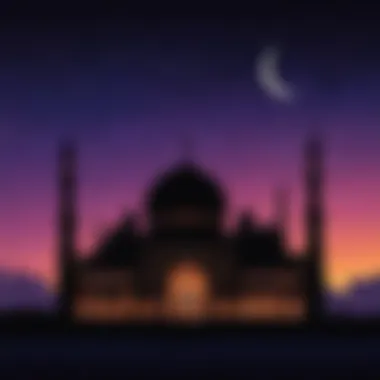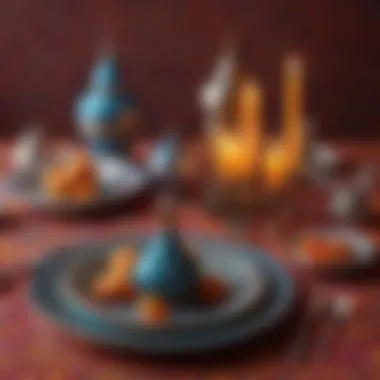Capturing the Essence of Ramadan: A Visual Exploration


Interactive Learning Games
The exploration of the significance of Ramadan through images introduces a profound visual journey into the cultural and spiritual essence of this sacred month. Through the eyes of artists and photographers, the essence and significance of Ramadan are vividly captured, offering viewers a glimpse into the rich traditions and rituals associated with this holy period. As the soft light of the moon adorns the night sky, these images convey a sense of peace, reflection, and devotion that define the spirit of Ramadan.
Educational Topics
In delving deeper into the visuals of Ramadan, one cannot ignore the educational aspects intertwined with the images. These images serve as powerful educational tools, providing invaluable insights into the cultural practices, beliefs, and values that shape the observance of Ramadan. Through exploring the images of Ramadan, viewers embark on a multidimensional educational journey that encompasses history, theology, sociology, and art.
Creative DIY Projects
Beyond the realm of observation lies the opportunity for creative engagement through do-it-yourself projects inspired by Ramadan imagery. These projects are not just about artistic expression but also serve as practical tools for deepening one's understanding of the cultural and spiritual significance of this sacred month. By translating visual representations into tangible creations, individuals of all ages can immerse themselves in the beauty and depth of Ramadan's traditions and rituals.
Introduction to Ramadan
Ramadan holds significant importance in the realm of Islamic faith. It is a time of spiritual reflection, self-improvement, and heightened devotion. During this sacred month, Muslims worldwide fast from dawn until sunset, refraining not only from food and drink but also from negative emotions and actions. This period serves as a means of purifying the soul and drawing closer to Allah. Ramadan signifies a time of heightened spirituality and observance, emphasizing the core principles of empathy, compassion, and community.
Overview of Ramadan
The significance of Ramadan in Islamic faith
Ramadan stands out as a pillar of Islamic faith, symbolizing submission, worship, and discipline. Through fasting, Muslims emulate the self-discipline and empathy for the less fortunate. It fosters a sense of unity among believers globally, reinforcing the ideals of equality and humility. The profound spiritual connection experienced during Ramadan transcends mere abstinence from food and water, encompassing a holistic approach to personal growth and servitude to Allah.
The lunar calendar and the observation of Ramadan
The Islamic calendar, a lunar-based system, dictates the observance of Ramadan. This lunar connection infuses the month with a mystical aura, aligning the practice with the periodic cycles of nature. The reliance on the lunar calendar enhances the spiritual nature of Ramadan, marking it not just as a temporal event but as a celestial phenomenon. The act of sighting the new moon to commence Ramadan attests to the celestial ties that underpin this sacred tradition.
The core principles and practices during Ramadan
At the heart of Ramadan lie fundamental principles that guide the believer towards spiritual enrichment. Fasting during this month instills self-discipline, patience, and gratitude. The emphasis on prayer and reflection encourages introspection and connection with Allah. Charity and acts of kindness reflect the essence of social responsibility and communal support. These core practices synergize to form a cohesive tapestry of devotion, symbolizing the multifaceted nature of Islamic faith.
Cultural and Spiritual Insights
The importance of fasting, prayer, and reflection
Fasting, prayer, and reflection constitute the foundational pillars of Ramadan, embodying the holistic approach to spiritual purification. Fasting serves as a physical and spiritual detoxification, emphasizing restraint and mindfulness. The practice of extended prayers fosters a sense of tranquility and connection to the divine. Reflection enables believers to contemplate their actions, seek forgiveness, and renew their spiritual intentions, thus reviving their commitment to Allah.
Community bonding and acts of charity during Ramadan


Ramadan serves as a catalyst for community cohesion and charitable endeavors. The act of fasting together unites individuals in a shared experience of worship and self-discipline. Acts of charity, such as feeding the needy and helping the less fortunate, embody the spirit of compassion and solidarity. These communal activities reinforce the importance of social welfare and mutual support, fostering a sense of belonging and shared responsibility.
The spiritual growth and self-discipline fostered
The month of Ramadan offers a transformative journey towards self-improvement and spiritual growth. Through the practice of fasting and increased devotion, individuals cultivate self-discipline, resilience, and patience. The spiritual regimen of Ramadan encourages believers to introspect, seek forgiveness, and strive for personal betterment. This period of heightened spirituality serves as a springboard for long-term habits of mindfulness, compassion, and self-awareness, shaping individuals into more conscientious and spiritually aware beings.
Visual Representation of Ramadan
Exploring the Significance, Benefits, and Considerations Surrounding Visual Representation of Ramadan:
In delving into the intricate tapestry of Ramadan through the lens of visual representation, we unearth a treasure trove of cultural and spiritual insights encapsulated within each image. Ramadan, a sacred month observed by Muslims worldwide, carries profound significance that transcends words, making visual representation a vivid portal into its essence. From photography to art, these images not only capture moments but also convey emotions, traditions, and the collective spirit resonating throughout this holy period.
Photography in Ramadan
The role of photography in capturing Ramadan moments
By dissecting the role of photography in capturing Ramadan moments, we unravel a realm where ordinary instances metamorphose into eternal fragments of time. Photography, as a medium, immortalizes fleeting emotions, communal gatherings, and individual contemplations during Ramadan. It acts as a visual chronicle, preserving unique narratives that might otherwise evaporate into the past unrecorded. The portrayal of mundane acts like Suhoor or Iftar transforms into a visual symphony that echoes the essence of togetherness and spiritual devotion.
Emotional and cultural impact of Ramadan photography
Within the emotional and cultural vista of Ramadan photography, every image becomes a tableau vivant narrating stories of patience, resilience, and faith. These images evoke a sense of solidarity, invoking empathy and understanding across diverse cultural landscapes. They serve as bridges, connecting hearts and minds through shared human experiences, fostering a bond that transcends language barriers and geographical divides.
Popular themes and subjects in Ramadan photography
Unveiling the popular themes and subjects in Ramadan photography unveils a mosaic of diversity, reflecting an array of traditions and practices intrinsic to this revered month. From the intricate patterns of Islamic architecture to the mesmerizing hues of lanterns adorning streets, each frame captures a facet of Ramadan's kaleidoscope. The interplay of light and shadow, the expression of joyous celebrations, and the silent reverie of prayer collectively form a visual narrative that speaks volumes without uttering a single word.
Artistic Expressions of Ramadan
Paintings, calligraphy, and other artistic mediums in Ramadan art
Engaging with paintings, calligraphy, and other artistic mediums in Ramadan art unveils a realm where creativity intertwines with spirituality. These artistic expressions transcend mere visuals, delving into the realm of symbolism and deeper meanings. The strokes of a calligraphic pen or the brushstrokes on canvas become conduits for expressing devotion, gratitude, and introspection inherent in Ramadan's essence.
The symbolism and storytelling in Ramadan art
The symbiotic relationship between symbolism and storytelling in Ramadan art renders each creation a tapestry of meanings waiting to be unraveled. Through intricate patterns, allegorical motifs, and emotive colors, artists embed layers of interpretations that invite viewers into a contemplative dialogue with the artwork. Each piece whispers tales of tradition, spirituality, and cultural heritage, inviting reflection and introspection on the essence of Ramadan.
Contemporary interpretations of Ramadan through art


Delving into contemporary interpretations of Ramadan through art opens a portal to innovation and evolution within a traditional sphere. As artists infuse modern elements and perspectives into their creations, a dynamic fusion of the past and present emerges. This fusion not only revitalizes artistic expressions but also propels the narrative of Ramadan into new horizons, fostering dialogue, diversity, and cross-cultural exchange.
Impact of Ramadan Images
Social Media and Digital Platforms
The role of social media in sharing Ramadan visuals
In the digital era, social media serves as a powerful platform for disseminating Ramadan visuals to a global audience. The immediacy and reach of social media platforms enable individuals to share their unique perspectives and experiences of Ramadan through images. The role of social media in sharing Ramadan visuals facilitates cross-cultural exchanges and fosters mutual understanding by allowing individuals to connect over shared traditions and values, transcending geographical constraints to create a sense of community.
Influence of Ramadan images on digital narratives
Images have a compelling influence on digital narratives surrounding Ramadan, shaping the way the world perceives this sacred month. Through visual storytelling, these images evoke emotions, trigger discussions, and highlight the diverse practices within the global Muslim community. The portrayal of Ramadan images in digital spaces amplifies awareness and appreciation for the cultural richness of this period, dispelling misconceptions and promoting intercultural dialogue.
Engagement and outreach through Ramadan visuals
The engaging nature of Ramadan visuals enables individuals to connect on a deeper level with the spiritual and cultural significance of this holy month. By actively involving viewers in the visual narratives of Ramadan, these images spark curiosity, empathy, and reflection on shared values and humanity. Through strategic outreach and meaningful engagement with diverse audiences, Ramadan visuals serve as a bridge, fostering dialogue and empathy across different cultural contexts.
Cross-Cultural Understanding
Impact of Ramadan images on promoting cultural awareness
Ramadan images play a pivotal role in promoting cultural awareness by showcasing the diverse traditions and practices observed during this holy month. Each image not only reflects the cultural richness of Ramadan but also encourages viewers to appreciate the nuances and variations within Islamic traditions worldwide. By sharing visual representations of Ramadan, communities can enhance their cultural literacy and cultivate respect for different ways of observing this sacred period.
Global appreciation of diverse Ramadan traditions
Images capturing diverse Ramadan traditions help cultivate a global appreciation for the multifaceted nature of this sacred month. Through visual storytelling, individuals from various backgrounds can gain insights into the unique rituals and ceremonies associated with Ramadan across different regions. This global perspective fosters a spirit of inclusivity and acceptance, promoting unity amidst cultural diversity and encouraging intercultural dialogue.
Enhanced dialogue and mutual respect through visual representations
Visual representations of Ramadan serve as powerful tools for enhancing dialogue and fostering mutual respect across diverse communities. By visually communicating the shared values of compassion, spirituality, and community building inherent in Ramadan, these images bridge cultural divides and facilitate meaningful interactions. Through respectful and authentic visual storytelling, individuals can engage in constructive conversations, bridging cultural divides and promoting a deeper understanding of the universal significance of Ramadan.
Challenges and Controversies
As we delve into the realm of challenges and controversies surrounding the visual representation of Ramadan, it becomes evident that this aspect plays a critical role in shaping our understanding of this sacred month. By shedding light on the complexities and nuances inherent in capturing the essence of Ramadan through images, we can navigate a path towards greater awareness and appreciation. These challenges and controversies serve as unfiltered mirrors reflecting the diverse perspectives and interpretations associated with Ramadan visuals, prompting us to question cultural norms, ethical boundaries, and storytelling responsibilities in visual media.
Ethical Considerations in Sharing Images


Respect for privacy and sanctity of Ramadan moments
When exploring the delicate balance between capturing poignant moments during Ramadan and respecting the privacy and sanctity of these experiences, we are faced with a profound ethical responsibility. This aspect underscores the need for sensitivity and mindfulness when documenting intimate moments of prayer, reflection, and community bonding. The key characteristic of respecting privacy and sanctity lies in recognizing the boundaries of personal expression and sacred rituals, ensuring that the imagery reflects reverence and authenticity. By upholding the sanctity of these moments, we preserve the intrinsic value of individual experiences and promote a culture of trust and dignity in visual storytelling.
Issues of consent and permission in photographing during Ramadan
The issue of consent and permission in photographing during Ramadan brings to the forefront the significance of gaining explicit approval and understanding from individuals featured in visual narratives. This ethical consideration emphasizes the importance of honoring personal boundaries and cultural practices when capturing images that involve human subjects. The key characteristic here lies in obtaining informed consent, respecting the autonomy of individuals in controlling their visual representation, and articulating the significance of their participation in the creative process. By upholding ethical standards of consent, we establish a foundation of trust and collaboration in creating visual narratives that honor the diversity and agency of the community being represented.
Balancing cultural sensitivity and artistic expression
The delicate balance between cultural sensitivity and artistic expression represents a fundamental challenge in visually representing the essence of Ramadan. This aspect requires a nuanced approach that respects cultural traditions, religious sensitivities, and social norms while fostering artistic interpretation and creative innovation. The key characteristic here is the ability to navigate between preserving the integrity of cultural symbols and narratives while exploring new forms of visual expression that resonate with contemporary audiences. By striking a balance between cultural authenticity and artistic experimentation, we can create visual narratives that contribute to cross-cultural dialogue, foster understanding, and celebrate the richness of diverse visual traditions.
Misinterpretation and Misrepresentation
Media portrayal and stereotypes related to Ramadan visuals
The portrayal of Ramadan visuals in the media often perpetuates stereotypes and narrow representations that fail to capture the true essence and diversity of this sacred month. This aspect highlights the need to challenge prevailing narratives, debunk misconceptions, and offer a more nuanced perspective that reflects the complexities of Ramadan traditions. The key characteristic of addressing media portrayal and stereotypes lies in advocating for accurate and multifaceted depictions that showcase the richness of cultural practices, spiritual meanings, and communal experiences associated with Ramadan. By confronting stereotypes and promoting authentic representations, we can empower diverse voices, foster greater cultural understanding, and enrich the visual discourse surrounding Ramadan.
The dangers of promoting misleading narratives through images
The dangers of promoting misleading narratives through images underscore the ethical responsibility of creators and audiences alike to critically engage with visual representations of Ramadan. This aspect emphasizes the potential impact of misleading visuals in reinforcing harmful stereotypes, perpetuating misinformation, and distorting the reality of Ramadan practices. The key characteristic here is the imperative to maintain truthfulness, accuracy, and cultural sensitivity in visual storytelling, ensuring that images reflect the authentic lived experiences of individuals and communities. By being vigilant against misleading narratives, we safeguard the integrity of visual representations and contribute to a more informed and respectful discourse surrounding Ramadan visuals.
Addressing misconceptions and promoting accurate depictions
Addressing misconceptions and promoting accurate depictions in visual representations of Ramadan is essential for fostering a more inclusive and authentic portrayal of this sacred month. This aspect calls for a proactive engagement with stereotypes, biases, and misinformation surrounding Ramadan visuals, aiming to rectify distortions and elevate the visibility of diverse narratives. The unique feature of this endeavor lies in unraveling misconceptions through counter-narratives, promoting dialogue, and amplifying the voices of marginalized communities within the broader tapestry of Ramadan imagery. By advocating for accuracy and inclusivity, we can challenge misrepresentations, celebrate cultural diversity, and promote a more nuanced understanding of Ramadan through visual storytelling.
Conclusion: Ramadan Through a Different Lens
In this final section of the article, we delve into a unique perspective on Ramadan, exploring it through a different lens that offers fresh insights and portrayal of this sacred month. By highlighting the significance of viewing Ramadan through various visual mediums like photography and art, we aim to provide readers with a deeper understanding and appreciation for the multifaceted nature of this religious observance. This section serves as a bridge between the cultural, spiritual aspects of Ramadan and how they are interpreted and shared through visual representations.
Reflecting on the Essence of Ramadan
Appreciating the multifaceted nature of Ramadan through images
The appreciation of the multifaceted nature of Ramadan through images is a pivotal aspect of this article. By delving into the diverse dimensions of Ramadan captured through visual art forms, we aim to showcase the richness and complexity of this sacred month. The varied themes, emotions, and cultural elements depicted in these images enable readers to grasp the depth of traditions and rituals associated with Ramadan. This exploration not only adds layers of understanding to the readers' perception but also aids in creating a vivid tapestry of experiences that define the essence of Ramadan.
Encouraging dialogue and understanding through visual representations
Encouraging dialogue and understanding through visual representations play a crucial role in bridging cultural and communal gaps. By showcasing how images of Ramadan can serve as powerful tools for communication and empathy, this article seeks to foster meaningful conversations and connections among individuals from diverse backgrounds. Visual representations have the unique ability to transcend language barriers, making them an effective medium for promoting cross-cultural understanding and mutual respect. Through these exchanges, readers are encouraged to engage in enriching dialogues that promote unity and empathy.
Embracing diversity and unity in the portrayal of Ramadan
Embracing diversity and unity in the portrayal of Ramadan is a central theme of this article. By celebrating the myriad interpretations and depictions of Ramadan across different cultures and artistic styles, we aim to showcase the universal values and teachings embodied in this holy month. Embracing the diverse representations of Ramadan not only highlights the global relevance of this observance but also underscores the common humanity that unites us all. By embracing this diversity in visual portrayals, we reinforce the message of unity and inclusivity that lies at the heart of Ramadan's teachings.















